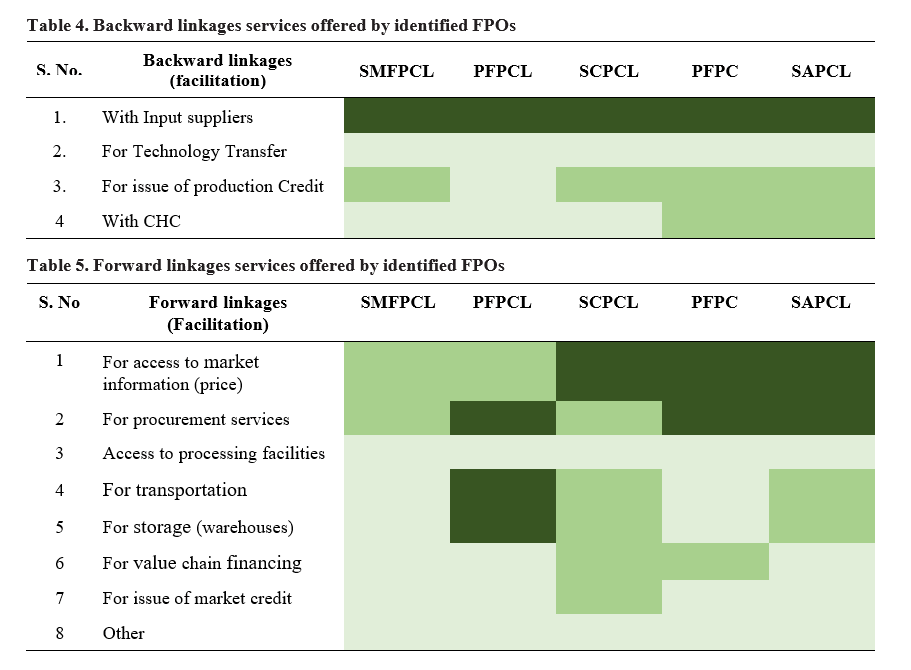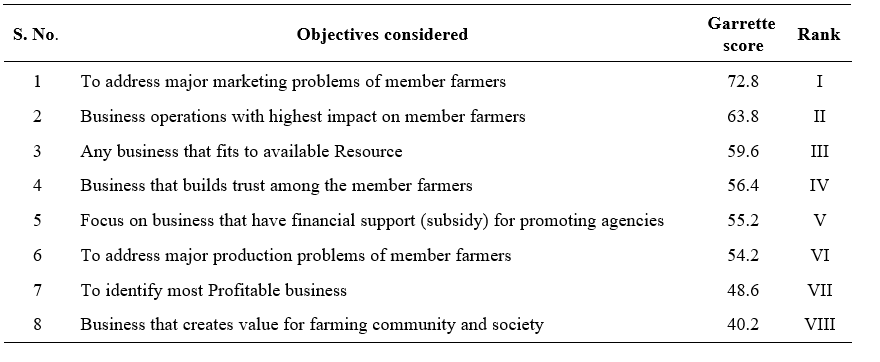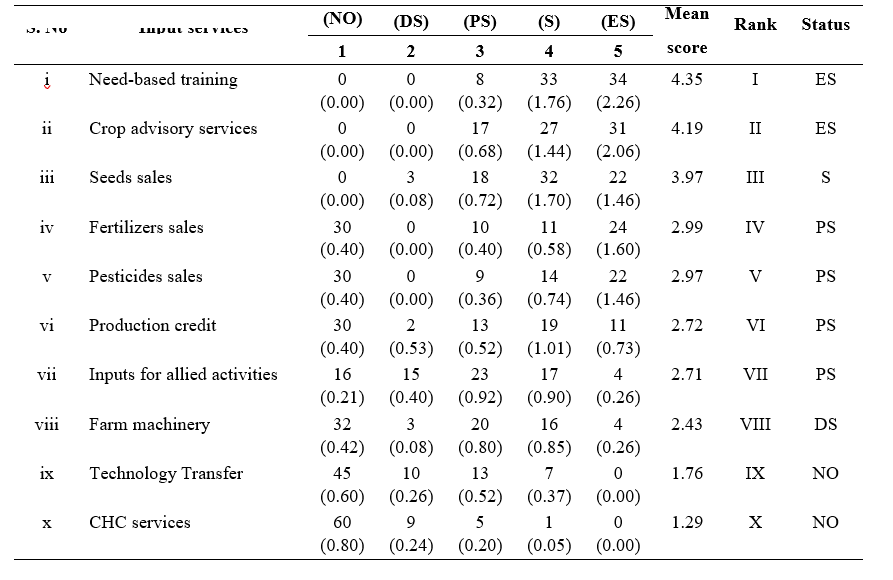Understanding and Assessing the Current Business Operations Performed by Identified Farmer Producer Organisation In Guntur District of Andhra Pradesh
0 Views
I. MONIKA*, N.T. KRISHNA KISHORE, P.V. SATYA GOPAL AND B. RAMANA MURTHY.
Institute of Agribusiness Management, S.V. Agricultural College, ANGRAU, Tirupati-517502.
ABSTRACT
The paper entitled “Understanding and assessing the current business operations performed by identified FPOs in Guntur district of Andhra Pradesh” was undertaken to investigate the current business operations performed by FPOs, the operations offered by FPOs have been categorized into pre harvest (production centric services), post-harvest, marketing operations. Perception of Board of Directors and satisfaction levels of member farmers were analysed to assess current business operations. Andhra Pradesh state of Southern India was purposively selected for the study as the researcher hails from the same state. Guntur, being agriculturally vibrant was an important district of Andhra Pradesh, due to diversified farming well established FPOs were operating in this area. Five FPOs were identified randomly from 5 mandals of Guntur district. According to the analysed data, the FPOs were extending their operations in production, post-harvest, marketing, forward linkage facilitation, backward linkage facilitation, capacity building and training to member farmers. It was found that the major production centric service offered by selected FPOs was crop advisory services, and post-harvest service offered by selected three FPOs was grading and sorting. While major marketing service offered by all the five selected FPOs were aggregation of produce and access to new markets. The major forward linkage facilitated was for access to market information and backward linkage facilitated was for input supplies. While major trainings on crop management techniques offered were soil health and crop management.
KEYWORDS: FPOs, Current business operations, Forward linkage facilitation, Backward linkage facilitation, Capacity building.
INTRODUCTION
India was at the forefront of agricultural growth worldwide, it was the backbone of the economy, where it contribution was about 18 per cent to GDP and nearly 58 per cent of Indian population depends on agriculture in which 70 per cent of rural population was directly dependent on agriculture as a primary source of income. It was dominated by small and marginal farmers by over 86 per cent. To provide strength and efficiency to the marketing system, alternatives were necessary for enhancing their income levels. One of the potential alternatives was grouping the farmers for collective action. To facilitate this process initially, there were three implementing agencies whose function was formation and promotion of FPOs, namely Small Farmers Agri- business Consortium (SFAC), National Cooperative Development Corporation (NCDC), National Bank for Agriculture and Rural Development (NABARD). The State and Central governments along with other agencies works on formation and promotion of active FPOs with the help of financial institutes and resources from various state sponsored and central funded schemes. The NABARD, SFAC, other Government agencies provides financial support to Producer Organisation Promoting Institution (POPI) to enhance the performance of PO.
MATERIAL AND METHODS
Parimala Flower Producer Company (PFPC), Sehamitha Agri Producer Company Limited (SAPCL), Sahajamitra Farmer Producer Company Limited (SFPCL), Spoorthi Chilli Producer Company Ltd (SCPCL), Prathipadu Farmer Producer Company Limited (PFPCL) were the five FPOs selected for the study. Purposive cum simple random sampling design was employed to investigate the variables in the study. Fifteen member farmers from each of the FPOs were randomly selected and interviewed. Thus, making sample size of 75 member farmers. While 5 Board of directors were selected purposively based on their activeness, making a total of 25 BODs from identified 5 FPOs. Thus, a total of 100 respondents were selected for the study.
RESULTS AND DISCUSSION
Particulars of different operations extended by selected FPOs
The Farmer Producer Organizations in the study area performs operations related to Pre- harvest(production), post-harvest, marketing, backward and forward linkages facilitation, technical support, capacity building to the farmers as mentioned below.

From Table 1, the analysed data of production centric operations by identified five FPOs commonly include crop advisory solutions as major activity.
From Table 2, the analysed data of post-harvest operations by selected five FPOs include Grading and sorting of harvested produce as major activity of SCPCL, PFPC, SAPCL. The remaining FPOs offers grading and sorting as a minor activity.
From Table 3, the marketing services by identified five (5) FPOs commonly include aggregation of produce from farmer members and providing access to new
Table 1. Production centric services offered by identified FPOs



markets. All the rest of marketing services such as branding, retailing were being considered either as major or minor activities by each FPO.
From Table 4, the backward linkages services by selected five FPOs commonly include facilitation with input suppliers, majority these FPOs has input supply dealings with Coramandel International company for supply of seeds and fertilisers as a major business activity.
From Table 5, the forward linkages facilitation services offered by selected five FPOs include access to Market information (price) as a major activity by SCPCL, PFPC, SAPCL.
From Table 6, the training and capacity building activities by selected five (5) FPOs commonly include soil health, crop, pest management, organic farming, Govt. schemes, value addition
Objectives, Reasons considered by Board members while identifying current business operations
It was important to understand the BODs and CEO’s criteria regarding the objectives, reasons considered while identifying current business operations.
From Table 7, we can interpret that the major objective considered by BODs and CEO of an FPO while identifying a business operation was to address the major marketing problems of member farmers with a highest mean score of 72.8 followed by the business activities those have higher impact on member farmers, which fits with available resources and builds trust among the members.
From Table 8, we can interpret that the major reasons considered for implementing a business operation were suggestion of a business opportunity by promoting agency which has obtained a highest mean score of 82.0 followed by the suggestion of BODs, member farmers, CEOs all these reasons were the primary considerations to choose the current business operations by an FPO.
Satisfaction levels of farmers towards current operations offered by Farmer Producer Operations in the study area.
The current business operations of the selected FPOs were being classified as input/pre-harvest services, post-harvest services, marketing services and the sample respondent’s satisfaction levels towards these activities were recorded. This five -point scale indicated the satisfaction level of member farmers by classifying them into extremely satisfied (ES), satisfied (S), partially satisfied (PS), dissatisfied (DS), service not offered (NO)
From Table 9, the satisfaction levels of member farmers towards production centric services infers that member farmers were dissatisfied towards farm machinery and partially satisfied towards sale of pesticides and fertilisers, production credit and inputs for allied activities.
Table 7. Objectives considered by BODs while identifying current business operations




From Table 10, the satisfaction levels of member farmers towards post harvest services infers that member farmers were dissatisfied towards grading and sorting, value addition services and partially satisfied towards warehousing services.
From Table 11, the satisfaction levels of member farmers towards marketing services infers that member farmers were dissatisfied towards value chain financing and partially satisfied towards branding/ retailing, transportation services.
The major production centric services offered by selected FPOs was crop advisory services, and post- harvest service offered by selected three FPOs was grading and sorting. While major marketing service offered by all the five selected FPOs were aggregation of produce and access to new markets. The major forward linkage facilitated was for access to market information and backward linkage facilitated was for input supplies. While major trainings on crop management techniques offered were soil health and crop management.
The major objective considered while identifying current business operations were addressing the major marketing problems of member farmers, business activities those have higher impact on member farmers, which fits with available resources and builds trust among the members were major objectives of BODs in considering current operations. According to the analysed data majority of the identified business operations were suggested by promoting agency. The BODs, member farmers, CEO also participates in identifying business operations for FPOs.
By analysing the satisfaction levels of member farmers towards current business operations performed by FPOs, it was clear that member farmers were highly satisfied with training programmes conducted by FPOs under input services and it infers that member farmers were dissatisfied towards farm machinery and partially satisfied towards sale of pesticides and fertilisers, production credit and inputs for allied activities. The member farmers were moderately satisfied with post- harvest operations provided by FPOs, it infers that member farmers were dissatisfied towards grading and sorting, value addition services and partially satisfied towards warehousing services. Member farmers were extremely satisfied with timely market information provided by FPOs as a part of marketing service, it infers that member farmers were dissatisfied towards value chain financing and partially satisfied towards branding/ retailing, transportation services.
LITERATURE CITED
Alagh, Y. 2007. On producer companies, paper presented at the workshop organized by professional Assistance for Development Action (PRADAN) on linking small producers to markets through producer companies at New Delhi. December, 2007.
Bikkina, N., Turanga, R.M.R and Bhamoriya, V. 2008. Farmer producer organizations as farmer collectives: A case study from Indian Institute of Management, Ahmedabad.
Garg, T. 2012. Business performance of a producer company in Madhya Pradesh. Project report MBA (Agri-Business Management) submitted to University of Agricultural Sciences, Bangalore.
Karami, E and Rezaei, M.K. 2005. Modeling determinants of agricultural production cooperative’s performance in Iran. Agricultural Economics. 33: 305-314.
Venkattakumar, R and Sontakki, B. 2012. Producer companies in India-experience and implications. Indian Research Journal of Extension Education. 12(2): 154-160.
- Bio-Formulations for Plant Growth-Promoting Streptomyces SP.
- Brand Preference of Farmers for Maize Seed
- Issues That Consumer Experience Towards Online Food Delivery (Ofd) Services in Tirupati City
- Influence of High Density Planting on Yield Parameters of Super Early and Mid Early Varieties of Redgram (Cajanus Cajan (L.) Millsp.)
- Influence of Iron, Zinc and Supplemental N P K on Yield and Yield Attributes of Dry Direct Sown Rice
- Effect of Soil and Foliar Application of Nutrients on the Performance of Bold Seeded Groundnut (Arachis Hypogaea L.)

